
Chapter 15: Identification of Saliva
15.1: Biological Characteristics of Saliva
The human salivary glands produce 1.0–1.5 L of saliva daily.
About 70% of saliva is produced from the submandibular salivary glands, 25% from the parotids, and 5% from the sublingual salivary glands.
Saliva is largely water containing small quantities of electrolytes, proteins, antibodies, and enzymes.
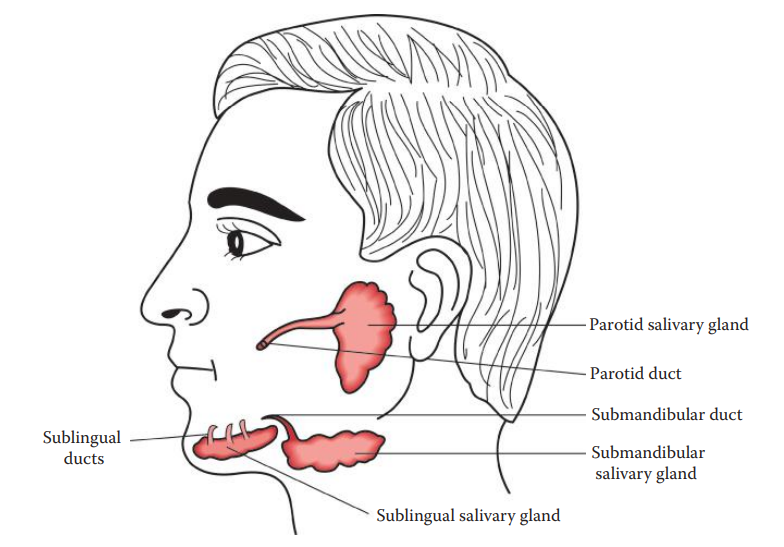
Amylases
Amylases: Are enzymes that cleave polysaccharides such as starches, which are composed of D-glucose units connected by α1→4 linkages.
Starches contain two types of glucose polymers:
Amylose consists of long, linear chains of glucose residues connected by α1→4 linkages.
Amylopectin is highly branched and consists of linear chains of glucose residues connected by α1→4 linkages with the branch points connected by α1→6 linkages.
Two types of amylases are characterized:
β-Amylases found in plant and bacterial sources cleave only at the terminal-reducing end of a polysaccharide chain.
Human α-amylases cleave at α1→4 linkages randomly along the polysaccharide chain.
Human salivary α-amylase (HSA): Encoded by the Amy1 locus, synthesized at the salivary glands and secreted into the oral cavity.
Human pancreatic α-amylase (HPA): Encoded by the Amy2 locus, is synthesized by the pancreas and secreted into the duodenum through the pancreatic duct.

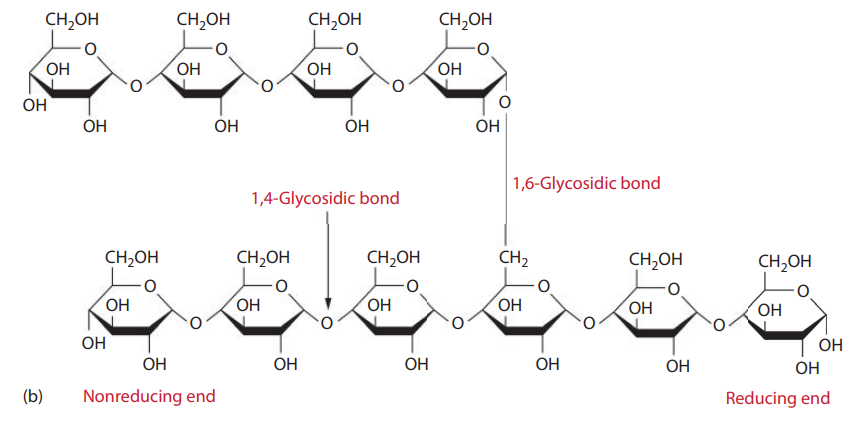
15.2: Analytical Techniques for Identification of Saliva
Presumptive Assays
Visual Examination
The lighting techniques used to search for semen stains can be utilized in searching for saliva stains.
Microscopic examination with proper histological staining can also be performed to identify the buccal epithelial cells, indicating the presence of a saliva stain.
Determination of Amylase Activity
Starch–Iodine Assay
Iodine is used to test for the presence of starch.
The amylose in starch reacts strongly with iodine to form a dark blue complex, while amylopectin develops a reddish-purple color.
Colorimetric Assays
Dye-labeled amylase substrates such as dye-conjugated amylose or amylopectin are utilized.
These substrates are not soluble in water.
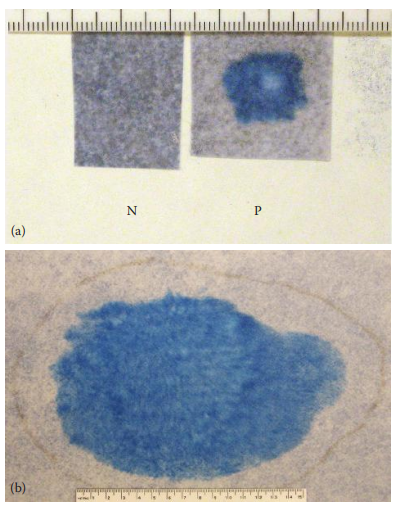

Confirmatory Assays
Identification of Human Salivary α-Amylase
Immunochromatographic Assays: RSID®-Saliva kit.
Enzyme-Linked Immunosorbent Assay (ELISA): Antibody—Antigen—Antibody Sandwich
RNA-Based Assay: These assays utilize reverse transcriptase polymerase chain reaction methods to detect gene expression levels of mRNAs for saliva identification.
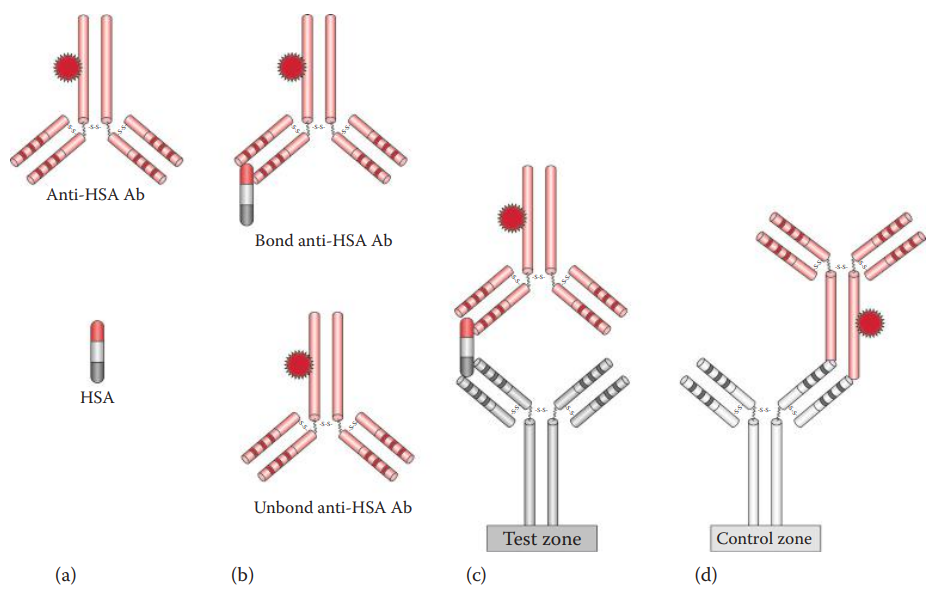
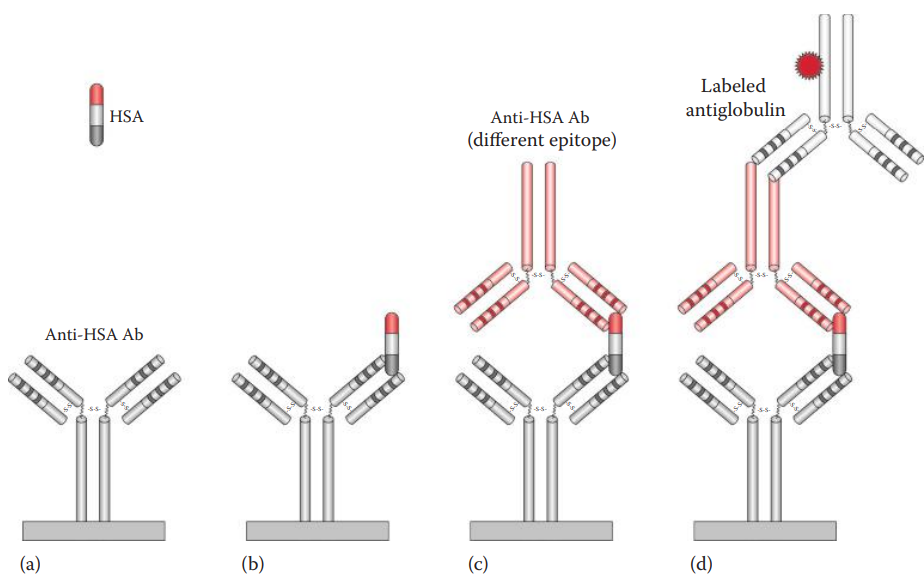
Application of RT-PCR Assay for Saliva Identification
Gene Symbol | Gene Product | Description |
|---|---|---|
HTN3 | Histatin 3 | Histidine-rich protein involved in nonimmune host defense in oral cavity. |
STATH | Statherin | Inhibitor of precipitation of calcium phosphate salts in oral cavity. |
Chapter 15: Identification of Saliva
15.1: Biological Characteristics of Saliva
The human salivary glands produce 1.0–1.5 L of saliva daily.
About 70% of saliva is produced from the submandibular salivary glands, 25% from the parotids, and 5% from the sublingual salivary glands.
Saliva is largely water containing small quantities of electrolytes, proteins, antibodies, and enzymes.

Amylases
Amylases: Are enzymes that cleave polysaccharides such as starches, which are composed of D-glucose units connected by α1→4 linkages.
Starches contain two types of glucose polymers:
Amylose consists of long, linear chains of glucose residues connected by α1→4 linkages.
Amylopectin is highly branched and consists of linear chains of glucose residues connected by α1→4 linkages with the branch points connected by α1→6 linkages.
Two types of amylases are characterized:
β-Amylases found in plant and bacterial sources cleave only at the terminal-reducing end of a polysaccharide chain.
Human α-amylases cleave at α1→4 linkages randomly along the polysaccharide chain.
Human salivary α-amylase (HSA): Encoded by the Amy1 locus, synthesized at the salivary glands and secreted into the oral cavity.
Human pancreatic α-amylase (HPA): Encoded by the Amy2 locus, is synthesized by the pancreas and secreted into the duodenum through the pancreatic duct.


15.2: Analytical Techniques for Identification of Saliva
Presumptive Assays
Visual Examination
The lighting techniques used to search for semen stains can be utilized in searching for saliva stains.
Microscopic examination with proper histological staining can also be performed to identify the buccal epithelial cells, indicating the presence of a saliva stain.
Determination of Amylase Activity
Starch–Iodine Assay
Iodine is used to test for the presence of starch.
The amylose in starch reacts strongly with iodine to form a dark blue complex, while amylopectin develops a reddish-purple color.
Colorimetric Assays
Dye-labeled amylase substrates such as dye-conjugated amylose or amylopectin are utilized.
These substrates are not soluble in water.


Confirmatory Assays
Identification of Human Salivary α-Amylase
Immunochromatographic Assays: RSID®-Saliva kit.
Enzyme-Linked Immunosorbent Assay (ELISA): Antibody—Antigen—Antibody Sandwich
RNA-Based Assay: These assays utilize reverse transcriptase polymerase chain reaction methods to detect gene expression levels of mRNAs for saliva identification.


Application of RT-PCR Assay for Saliva Identification
Gene Symbol | Gene Product | Description |
|---|---|---|
HTN3 | Histatin 3 | Histidine-rich protein involved in nonimmune host defense in oral cavity. |
STATH | Statherin | Inhibitor of precipitation of calcium phosphate salts in oral cavity. |
 Knowt
Knowt
